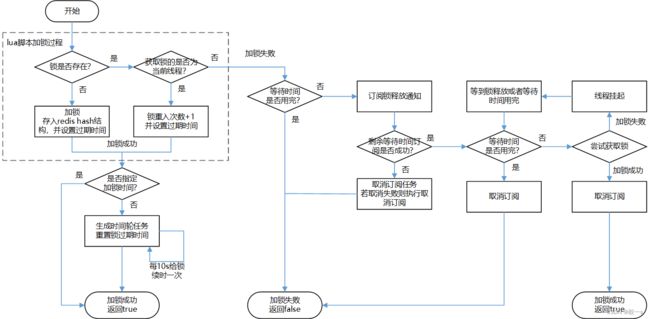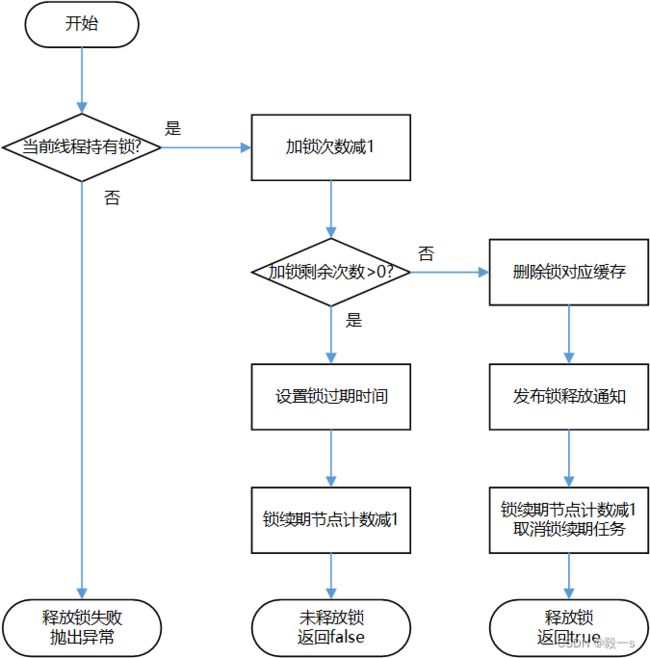Redisson分布式锁原理浅析
Redisson分布式锁原理浅析
- 一、初始化
- 二、加锁
- 三、释放锁
Redisson锁是我们常用的分布式锁,其核心方法就是获取锁对象(getLock)、加锁(lock、tryLock)和释放锁(unlock),下面从锁的初始化、加锁和释放锁三部分分析Redisson锁的原理。
一、初始化
这里我们一般使用Redisson的getLock方法获取RLock锁对象
public RLock getLock(String name) {
return new RedissonLock(connectionManager.getCommandExecutor(), name);
}
在getLock方法中新建了一个RedissonLock对象,其源码是
public RedissonLock(CommandAsyncExecutor commandExecutor, String name) {
// 父类的构造方法,最终是RedissonObject
super(commandExecutor, name);
// 初始化命令执行器
this.commandExecutor = commandExecutor;
// 初始化id,用于锁的前缀
this.id = commandExecutor.getConnectionManager().getId();
// 初始化锁的默认时间,这里采用的是看门狗的时间,默认30s
this.internalLockLeaseTime = commandExecutor.getConnectionManager().getCfg().getLockWatchdogTimeout();
// 锁的标识
this.entryName = id + ":" + name;
// 初始化锁的监听器,用于在锁被占用时,使用Redis的pub/sub功能订阅锁释放消息
this.pubSub = commandExecutor.getConnectionManager().getSubscribeService().getLockPubSub();
}
二、加锁
加锁有lock和tryLock两类方法,区别在于tryLock方法会有一个等待时间,如果超过等待时间未获取到锁就会返回false,表示获取锁失败,而lock方法会一直等待,直到获取到锁,两者的源码相差不大,这里主要分析tryLock方法的源码。
源码分析如下:
@Override
public boolean tryLock(long waitTime, long leaseTime, TimeUnit unit) throws InterruptedException {
long time = unit.toMillis(waitTime);
long current = System.currentTimeMillis();
// 获取当前线程id
long threadId = Thread.currentThread().getId();
// 获取锁,底层实现是lua脚本,具体参考下面的tryAcquireAsync源码(这部分包括lua脚本加锁和加锁时间续期)
Long ttl = tryAcquire(leaseTime, unit, threadId);
// 锁获取成功,返回true
if (ttl == null) {
return true;
}
// 后面是锁获取失败的处理流程
time -= System.currentTimeMillis() - current;
// 等待时间用完,获取锁失败
if (time <= 0) {
acquireFailed(threadId);
return false;
}
current = System.currentTimeMillis();
// 订阅锁释放的通知
RFuture<RedissonLockEntry> subscribeFuture = subscribe(threadId);
// 剩余时间内未订阅成功
if (!subscribeFuture.await(time, TimeUnit.MILLISECONDS)) {
// 尝试取消订阅过程,若无法取消,则会取消订阅
if (!subscribeFuture.cancel(false)) {
subscribeFuture.onComplete((res, e) -> {
if (e == null) {
unsubscribe(subscribeFuture, threadId);
}
});
}
// 获取锁失败
acquireFailed(threadId);
return false;
}
try {
time -= System.currentTimeMillis() - current;
// 等待时间用完,加锁失败
if (time <= 0) {
acquireFailed(threadId);
return false;
}
// 自旋获取锁
while (true) {
// 尝试获取锁
long currentTime = System.currentTimeMillis();
ttl = tryAcquire(leaseTime, unit, threadId);
// 获取成功
if (ttl == null) {
return true;
}
// 未获取成功,若等待时间用完,则加锁失败
time -= System.currentTimeMillis() - currentTime;
if (time <= 0) {
acquireFailed(threadId);
return false;
}
// 通过java.util.concurrent包的Semaphore(信号量)挂起线程等待锁释放
currentTime = System.currentTimeMillis();
if (ttl >= 0 && ttl < time) {
getEntry(threadId).getLatch().tryAcquire(ttl, TimeUnit.MILLISECONDS);
} else {
getEntry(threadId).getLatch().tryAcquire(time, TimeUnit.MILLISECONDS);
}
// 等待时间已用完,获取锁失败
time -= System.currentTimeMillis() - currentTime;
if (time <= 0) {
acquireFailed(threadId);
return false;
}
}
} finally {
// 取消订阅锁释放
unsubscribe(subscribeFuture, threadId);
}
// return get(tryLockAsync(waitTime, leaseTime, unit));
}
private <T> RFuture<Long> tryAcquireAsync(long leaseTime, TimeUnit unit, long threadId) {
// 指定加锁时间
if (leaseTime != -1) {
// lua脚本加锁,详细见tryLockInnerAsync源码
return tryLockInnerAsync(leaseTime, unit, threadId, RedisCommands.EVAL_LONG);
}
// 未指定加锁时间,则异步执行尝试获取锁,加锁时间是默认的30s
RFuture<Long> ttlRemainingFuture = tryLockInnerAsync(commandExecutor.getConnectionManager().getCfg().getLockWatchdogTimeout(), TimeUnit.MILLISECONDS, threadId, RedisCommands.EVAL_LONG);
ttlRemainingFuture.onComplete((ttlRemaining, e) -> {
if (e != null) {
return;
}
// 获取锁成功,开启时间轮任务,用于锁续期
if (ttlRemaining == null) {
scheduleExpirationRenewal(threadId);
}
});
return ttlRemainingFuture;
}
private void scheduleExpirationRenewal(long threadId) {
ExpirationEntry entry = new ExpirationEntry();
// 获取当前线程的锁续期任务节点
ExpirationEntry oldEntry = EXPIRATION_RENEWAL_MAP.putIfAbsent(getEntryName(), entry);
if (oldEntry != null) {
// 若当前线程的锁续期任务任务节点已存在,将节点计数加1
oldEntry.addThreadId(threadId);
} else {
// 不存在,说明是新的线程获取锁
// 将节点计数加1
entry.addThreadId(threadId);
// 开始时间轮调度任务
// 其会每10s执行一次调度任务,给锁续期
renewExpiration();
}
}
这里可以看到在不指定锁的过期时间时,Redisson会自动给锁续期,这可以解决业务未执行完锁就释放的问题,但同时也有缺点,若系统出现异常,锁未执行到finally的unlock,就会造成死锁,其他的线程将无法再获取到该锁。在日常编码中,我们更偏向于指定锁的过期时间,保证在异常情况下锁也能够被释放,至于业务未执行完锁就释放的问题,通过合理评估业务耗时,合理设置过期时间即可。
锁每次重入都会将锁续期任务节点的计数加1,是为了在释放锁的时候判断释放几次后将锁续期任务停止。
下面看一下锁存入redis的lua脚本:
<T> RFuture<T> tryLockInnerAsync(long leaseTime, TimeUnit unit, long threadId, RedisStrictCommand<T> command) {
internalLockLeaseTime = unit.toMillis(leaseTime);
// KEYS[1]为 Collections.
// ARGV[1]是internalLockLeaseTime,即为过期时间
// ARGV[2]是getLockName(threadId),为锁的唯一标识
return commandExecutor.evalWriteAsync(getName(), LongCodec.INSTANCE, command,
// 判断锁是否存在
"if (redis.call('exists', KEYS[1]) == 0) then " +
// 锁不存在,通过hash结果进行存储,hash-key是前缀+线程id,value是1,表示第一次加锁
"redis.call('hset', KEYS[1], ARGV[2], 1); " +
// 设置过期时间
"redis.call('pexpire', KEYS[1], ARGV[1]); " +
// 返回null,加锁成功
"return nil; " +
"end; " +
// 锁已存在,判断是否是当前线程获取到锁
"if (redis.call('hexists', KEYS[1], ARGV[2]) == 1) then " +
// 是当前线程获取到锁,将hash的value加1,表示锁的进入次数加1
"redis.call('hincrby', KEYS[1], ARGV[2], 1); " +
// 设置过期时间
"redis.call('pexpire', KEYS[1], ARGV[1]); " +
// 返回null,加锁成功
"return nil; " +
"end; " +
// 返回锁的过期时间,表示获取锁失败
"return redis.call('pttl', KEYS[1]);",
Collections.<Object>singletonList(getName()), internalLockLeaseTime, getLockName(threadId));
}
通过truLockInnerAsync的源码不难分析Redisson锁的存储结构,Redisson锁采用的是hash结构,Redis 的Key为锁名,也就是初始化时传入的name参数,hash的key为锁的id属性+线程id,hash的value为加锁次数,不难看出Redisson分布式锁是可重入的。
综上,加锁的流程如下:

三、释放锁
释放锁一般在finally代码块里执行unlock方法,核心方法是unlockAsync,其源码如下:
@Override
public RFuture<Void> unlockAsync(long threadId) {
RPromise<Void> result = new RedissonPromise<Void>();
// 释放锁
RFuture<Boolean> future = unlockInnerAsync(threadId);
future.onComplete((opStatus, e) -> {
if (e != null) {
// 释放异常,取消锁续期任务
cancelExpirationRenewal(threadId);
result.tryFailure(e);
return;
}
// 返回为null,表示该线程未拥有该锁,抛出异常
if (opStatus == null) {
IllegalMonitorStateException cause = new IllegalMonitorStateException("attempt to unlock lock, not locked by current thread by node id: "
+ id + " thread-id: " + threadId);
result.tryFailure(cause);
return;
}
// 取消锁续期任务
cancelExpirationRenewal(threadId);
result.trySuccess(null);
});
return result;
}
protected RFuture<Boolean> unlockInnerAsync(long threadId) {
//keys[1]]为 Arrays.
//keys[2]为Arrays.
//ARGV[1]为LockPubSub.UNLOCK_MESSAGE,是发布锁释放事件类型
//ARGV[2]为internalLockLeaseTime,即过期时间
//ARGV[3]为getLockName(threadId),是锁的唯一标识
return commandExecutor.evalWriteAsync(getName(), LongCodec.INSTANCE, RedisCommands.EVAL_BOOLEAN,
"if (redis.call('hexists', KEYS[1], ARGV[3]) == 0) then " +
// 锁不存在,返回null
"return nil;" +
"end; " +
// 加锁次数减1
"local counter = redis.call('hincrby', KEYS[1], ARGV[3], -1); " +
"if (counter > 0) then " +
// 剩余次数大于0
// 设置过期时间,时间为30s
"redis.call('pexpire', KEYS[1], ARGV[2]); " +
// 返回0
"return 0; " +
"else " +
// 剩余次数小于等于0
// 删除缓存
"redis.call('del', KEYS[1]); " +
// 发布锁释放通知
"redis.call('publish', KEYS[2], ARGV[1]); " +
// 返回1
"return 1; "+
"end; " +
"return nil;",
Arrays.<Object>asList(getName(), getChannelName()), LockPubSub.UNLOCK_MESSAGE, internalLockLeaseTime, getLockName(threadId));
}
释放锁的流程主要是减少redis中锁的次数,若为0则删除缓存,同时减少锁续期任务节点的计数,若为0,则停止锁续期任务,其流程如下:

以上就是Redisson锁的主要原理。
值得注意的是,如果采用redis-cluster模式,master节点加锁成功,在主从同步时,master节点异常,主从切换,slave节点变成master,此时加锁数据还未同步成功,也就是变成master的slave节点中没有该锁的数据,当其他线程再次对该锁进行加锁操作时,就会有两个线程拥有该锁,会造成并发问题。